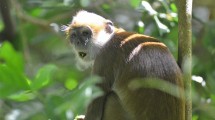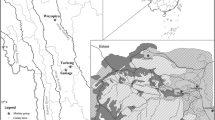Abstract
Forest guenons (Cercopithecus spp.) are often found in polyspecific associations that may decrease predator risk while increasing interspecific competition for food. Cheek pouch use may mitigate interspecific competition and predator risk by reducing the time spent in areas of high competition/predator risk. I investigated these ideas in three forest guenons: Campbell’s monkey (Cercopithecus campbelli), spot-nosed monkey (C. petaurista), and Diana monkey (C. diana). I present 13 months of scan sample data from Taï Forest, Côte d’Ivoire, including 3,675, 3,330, and 5,689 records of cheek pouch distention, to quantify cheek pouch use, for Campbell’s, spot-nosed, and Diana monkeys, respectively. Cheek pouches are often used to hold fruit, so I first predicted that the most frugivorous species, Diana monkeys, would have the most cheek pouch distension. Spot-nosed monkeys ate the least amount of fruit over the study period and had the least distended cheek pouches, suggesting the importance of frugivory in relation to cheek pouch distension for this species. This was not a sufficient explanation for Campbell’s monkeys; Campbell’s ate fruit less than Diana monkeys, but had more distended cheek pouches, suggesting that cheek pouch use was not simply a reflection of high frugivory. From the interspecific competition hypothesis, I predicted that Campbell’s monkeys would have more distended cheek pouches than Diana and spot-nosed monkeys, and more distended cheek pouches when associated with Diana because Campbell’s monkeys have the highest potential for interspecific competition with dominant Diana monkeys. From the predator risk hypothesis, I predicted that Campbell’s would have more distended cheek pouches when not associated with highly vigilant Diana monkeys. Campbell’s monkeys had the most distended cheek pouches overall, but had more distended cheek pouches when not in association with Diana, suggesting the greater importance of predator risk rather than interspecific competition in Campbell’s cheek pouch use.
Similar content being viewed by others
References
Altmann J (1974) Observational study of behavior: sampling methods. Behaviour 49:227–267
Boesch C, Boesch H (1989) Hunting behavior of wild chimpanzees in the Taï National Park. Am J Phys Anthropol 78:547–573
Boesch C, Boesch-Achermann H (2000) The Chimpanzees of the Taï Forest behavioural ecology and evolution. Oxford University Press, New York
Boinski S, Treves A, Chapman CA (2000) A critical evaluation of the influence of predators on primates: effects on group travel. In: Boinski S, Garber PA (eds) On the move: how and why animals travel in groups. University of Chicago Press, Chicago, pp 43–72
Bshary R (2001) Diana monkeys, Cercopithecus diana, adjust their anti-predator response behaviour to human hunting strategies. Behav Ecol Sociobiol 50:251–256
Bshary R, Noë R (1997) Anti-predation behavior of red colobus monkeys in the presence of chimpanzees. Behav Ecol Sociobiol 41:321–333
Buzzard PJ (2004) Interspecific competition among Cercopithecus campbelli, C. petaurista, and C. diana at Taï Forest, Côte d’Ivoire. PhD Thesis Columbia University, New York
Buzzard PJ (2006) Ecological partitioning in three guenons of the Taï Forest: Cercopithecus campbelli, C. petaurista and C. diana. Int J Primatol (in press)
Buzzard PJ, Eckardt W (2006) Social systems of the Taï guenons. In: Noë R, McGraw WS, Zuberbühler K (eds) Monkeys of the Taï Forest: an African primate community. Cambridge University Press, Cambridge (in press)
Chadwick-Jones JK (1989) Presenting and mounting in non-human primates: theoretical developments. J Soc Biol Stress 12:319–333
Cords M (2000) Mixed species association and group movement. In: Boinski S, Garber PA (eds) On the move: how and why animals travel in groups. University of Chicago Press, Chicago, pp 73–99
Eckardt W, Zuberbühler K (2004) Cooperation and competition in forest monkeys. Behav Ecol 15:400–411
Hayes VJ, Henzi SP, Freedman L, Gaynor D (1992) The differential use of cheek pouches in a troop of Papio ursinus. Primates 33:477–500
Korstjens AH (2001) The mob, the secret sorority, and the phantoms: an analysis of the socio-ecological strategies of the three colobines of Taï. Unpublished PhD Thesis, Utrecht University, The Netherlands
Lambert JE (2005) Competition, predation, and the evolutionary significance of the cercopithecine cheek pouch: the case of Cercopithecus and Lophocebus. Am J Phys Anthropol 126:183–192
Lehner PN (1996) Handbook of ethological methods. Cambridge University Press, Cambridge
McGraw WS (1996) Positional behavior and habitat use of six monkeys in the Taï Forest, Côte d’Ivoire. Unpublished PhD dissertation, State University of New York, Stony Brook
Murray PF (1975) The role of cheek pouches in cercopithecine monkey adaptive strategy. In: Tuttle RH (ed) Primate functional morphology and evolution. Moulton, Paris, pp 151–194
Napier PH (1981) Catalogue of primates in the British Museum (Natural History) and elsewhere in the British Isles, Part 2: Family Cercopithecidae, Subfamily Cercopithecinae. British Museum (Natural History), London
Noë R, Bshary R (1997) The formation of red colobus-diana monkey associations under predation pressure from chimpanzees. Proc R Soc Lond B 264:253–259
Oates JF, Whitesides GH, Davies AG, Waterman PG, Green SM, Dasilva GL, Mole S (1990) Determinants of variation in tropical forest primate biomass: new evidence from West Africa. Ecology 71:328–343
Richard AF (1985) Primates in nature. Freeman, New York
Smuts BB, Cheney DL, Seyfarth RM, Wrangham RW, Struhsaker TT (1987) Primate societies. University of Chicago Press, Chicago
Sokal RR, Rohlf FJ (1995) Biometry. Freeman, New York
Srivastava A, Borries C, Sommer V (1991) Homosexual mounting in free-ranging female Hanuman langurs (Presbytis entellus). Arch Sex Behav 20:487–512
Stoorvogel JJ (1993) Gross inputs and outputs of nutrients in disturbed Forest, Taï Area Côte d’Ivoire. Veenman Drukkers, Wageningen
Vander Wall SB, Longland WS, Pyare S, Veech JA (1998) Cheek pouch capacities and loading rates of heteromyid rodents. Oecologia 113:21–28
Wolters S, Zuberbühler K (2003) Mixed-species associations of Diana and Campbell’s monkeys: the costs and benefits of a forest phenomenon. Behaviour 140:371–385
Acknowledgements
I would like to thank the Minister of the environment and the forest, the Minister of scientific research, the director of the center for ecological research at Taï and the PACPNT of Côte d’Ivoire for giving me permission to work at Taï National Park. I would also like to thank the directors of the Taï Monkey Project (TMP), Ronald Noë, Klaus Zuberbühler, Scott McGraw, and Johannes Refisch or the opportunity to study with the TMP. I would like to thank my advisor, Marina Cords, members of my dissertation committee (John Oates, Don Melnick, Fred Koontz, and Cliff Jolly), and three anonymous reviewers for their comments and input towards the development of this manuscript. The field work was possible through a dissertation improvement grant from Leakey foundation and the methodology complied with the laws of Cote d’Ivoire.
Author information
Authors and Affiliations
Corresponding author
About this article
Cite this article
Buzzard, P.J. Cheek pouch use in relation to interspecific competition and predator risk for three guenon monkeys (Cercopithecus spp.). Primates 47, 336–341 (2006). https://doi.org/10.1007/s10329-006-0188-6
Received:
Accepted:
Published:
Issue Date:
DOI: https://doi.org/10.1007/s10329-006-0188-6




